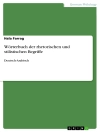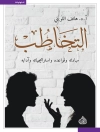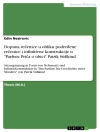Table of Content
Introduction
Stephan Elspaß: A twofold view ‘from below’: New perspectives on language histories and historical grammar;
I. Language variation in letters, diaries and other text sources from below
Marina Dossena: “As this leaves me at present” – Formulaic usage, politeness and social proximity in nineteenth-century Scottish emigrants’ letters; Tony Fairman: ‘Lower-order’ letters, schooling and the English language, 1795 to 1834; Nicola Mc Lelland: “Doch mein Mann möchte doch mal wissen …” A discourse analysis of 19th-century emigrant men and women’s private correspondence; Gertrud Reershemius: Remnants of Western Yiddish in East Frisia; Marijke van der Wal: Eighteenth-century linguistic variation from the perspective of a Dutch diary and a collection of private letters;
II. From past to present: Change from above – change from below
Joan C. Beal/Karen P. Corrigan: ‘Time and Tyne’: a corpus-based study of variation and change in relativization strategies in Tyneside English; David Denison: Syntactic surprises in some English letters: the underlying progress of the language; Richard Dury: YOU and THOU in Early Modern English: cross-linguistic perspectives; Kirstin Killie: On the history of verbal present participle converbs in English and Norwegian and the concept of ‘change from below’; Alexandra Lenz: The grammaticalization of geben ‘to give’ in German and Luxembourgish; Koen Plevoets/Dirk Speelman/Dirk Geeraerts: A corpus-based study of colloquial ‘Flemish’; Reinhild Vandekerckhove: ‘Tussentaal’ as a source of change from below in Belgian Dutch. A case study of substandardization processes in the chat language of Flemish teenagers;
III. Language norms and standardization in a view from below
Christa de Kleine: Surinamese Dutch: The Development of a Unique Germanic Language Variety; Ana Deumert: “Zoo schrijve ek lievers my sort Afrikaans”. Speaker agency, identity and resistance in the history of Afrikaans; Martin Durrell: “Deutsch ist eine würde-lose Sprache”. On the history of a failed prescription; Roswitha Fischer: To boldly split the infinitive – or not? Prescriptive traditions and current English usage; Amanda Pounder: Norm consciousness and corpus constitution in the study of Earlier Modern Germanic languages; Anja Voeste: Variability and professionalism as prerequisites of standardization; Evelyn Ziegler: Putting standard German to the test: Some notes on the linguistic competence of grammar-school students and teachers in the nineteenth century;
IV. Language choice and language planning
Steffen Arzberger: The choice between the German or French language for the German nobility of the late 18th Century; Jeroen Darquennes: Flirting at the fringe – The status of the German varieties as perceived by language activists in Belgium’s Areler Land; Kristine Horner: Language and Luxembourgish national identity: ideologies of hybridity and purity in the past and present; Ernst Håkon Jahr: The planning of modern Norwegian as a sociolinguistic experiment – ‘from below’; Péter Maitz: The death of Standard German in 19th century Budapest. A case study on the role of linguistic ideologies in language shift; Agnete Nesse: 1750-1850: The disappearance of German from Bergen, Norway; Stefaniya Ptashnyk: Societal multilingualism and language conflicts in Galicia in the 19th century; Eline Vanhecke/Jetje De Groof: New data on language policy and language choice in 19th-century Flemish city administrations;
V. Reflections on alternative language histories
Angelika Linke: Communicative genres as categories of a cultural history of communication; Richard J. Watts: Deconstructing episodes in the ‘history of English’
About the author
Stephan Elspaß, University of Augsburg, Germany; Nils Langer, University of Bristol, UK; Joachim Scharloth, University of Zurich, Switzerland; Wim Vandenbussche , Vrije Universiteit Brussel, Belgium.












